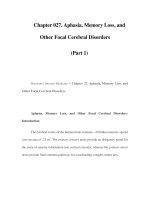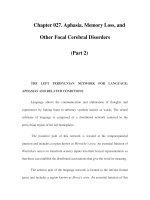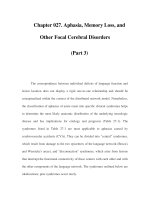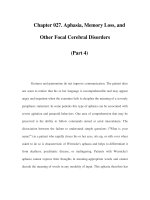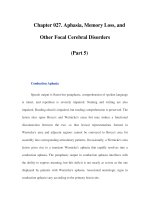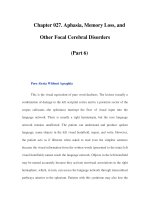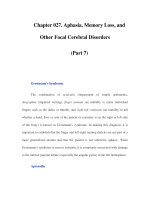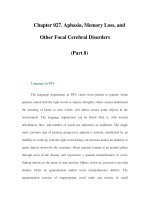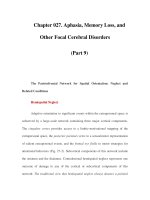Chapter 031. Pharyngitis, Sinusitis, Otitis, and Other Upper Respiratory Tract Infections (Part 6) pot
Bạn đang xem bản rút gọn của tài liệu. Xem và tải ngay bản đầy đủ của tài liệu tại đây (84.38 KB, 7 trang )
Chapter 031. Pharyngitis, Sinusitis, Otitis, and Other
Upper Respiratory Tract Infections
(Part 6)
Chronic otitis externa is caused primarily by repeated local irritation, most
commonly arising from persistent drainage from a chronic middle-ear infection.
Other causes of repeated irritation, such as insertion of cotton swabs or other
foreign objects into the ear canal, can lead to this condition, as can rare chronic
infections such as syphilis, tuberculosis, or leprosy. Chronic otitis externa
typically presents as erythematous, scaling dermatitis in which the predominant
symptom is pruritus rather than pain; this condition must be differentiated from
several others that produce a similar clinical picture, such as atopic dermatitis,
seborrheic dermatitis, psoriasis, and dermatomycosis. Therapy consists of
identifying and treating or removing the offending process, although successful
resolution is frequently difficult.
Invasive otitis externa, also known as malignant or necrotizing otitis
externa, is an aggressive and potentially life-threatening disease that occurs
predominantly in elderly diabetic patients and other immunocompromised
patients. The disease begins in the external canal, progresses slowly over weeks to
months, and often is difficult to distinguish from a severe case of chronic otitis
externa because of the presence of purulent otorrhea and an erythematous swollen
ear and external canal. Severe, deep-seated otalgia is often noted and can help
differentiate invasive from chronic otitis externa. The characteristic finding on
examination is granulation tissue in the posteroinferior wall of the external canal,
near the junction of bone and cartilage. If left unchecked, the infection can migrate
to the base of the skull (resulting in skull-base osteomyelitis) and on to the
meninges and brain, with a high associated mortality rate. Cranial nerve
involvement is occasionally seen, with the facial nerve usually affected first and
most often. Thrombosis of the sigmoid sinus can occur if the infection extends to
that area. CT, which can reveal osseous erosion of the temporal bone and skull
base, can be used to help determine the extent of disease, as can gallium and
technetium-99 scintigraphy studies. P. aeruginosa is by far the most common
pathogen, although S. aureus, Staphylococcus epidermidis, Aspergillus,
Actinomyces, and some gram-negative bacteria have also been associated with this
disease. In all cases, the external ear canal should be cleansed and a biopsy
specimen of the granulation tissue within the canal (or of deeper tissues) should be
obtained for culture of the offending organism. IV antibiotic therapy is directed
specifically toward the recovered pathogen. For P. aeruginosa, the regimen
typically includes an antipseudomonal penicillin or cephalosporin (e.g.,
piperacillin or ceftazidime) with an aminoglycoside. A fluoroquinolone antibiotic
is frequently used in place of the aminoglycoside and can even be administered
orally, given the excellent bioavailability of this drug class. In addition, antibiotic
drops containing an agent active against Pseudomonas (e.g., ciprofloxacin) are
usually prescribed and are combined with glucocorticoids to reduce inflammation.
Cases of invasive Pseudomonas otitis externa recognized in the early stages can
sometimes be treated with oral and otic fluoroquinolones alone, albeit with close
follow-up. Extensive surgical debridement, once an important component of the
treatment approach, is now rarely indicated.
Infections of Middle-Ear Structures
Otitis media is an inflammatory condition of the middle ear that results
from dysfunction of the eustachian tube in association with a number of illnesses,
including URIs and chronic rhinosinusitis. The inflammatory response to these
conditions leads to the development of a sterile transudate within the middle-ear
and mastoid cavities. Infection may occur if bacteria or viruses from the
nasopharynx contaminate this fluid, producing an acute (or sometimes chronic)
illness.
Acute Otitis Media
Acute otitis media results when pathogens from the nasopharynx are
introduced into the inflammatory fluid collected in the middle ear (e.g., by nose
blowing during a URI). The proliferation of these pathogens in this space leads to
the development of the typical signs and symptoms of acute middle-ear infection.
The diagnosis of acute otitis media requires the demonstration of fluid in the
middle ear (with tympanic membrane immobility) and the accompanying signs or
symptoms of local or systemic illness (Table 31-2).
Table 31-2 Guidelines for the Diagnosis and Treatment of Acute Otitis
Media
Illness
Severity
Diagnostic Criteria Treatment
Recommendations
Mild to
moderate
Fluid in the middle ear,
evidenced by decreased tympanic
membrane mobility, air/fluid
level behind tympanic
membrane, bulging tymp
anic
membrane, purulent otorrhea
and
Acute onset of signs and
symptoms of middle-
ear
inflammation, including fever,
Initial therapy
a
Observation alone
(symptom relief only)
b
or
Amoxicillin, 80–
90
mg/kg qd (up to 2 g) PO in
divided doses (bid or tid),
or
Cefdinir, 14 mg/kg qd
PO in 1 dose or divided doses
(bid), or
Cefuroxime, 30 mg/kg
qd PO in divided doses (bid),
or
Azithromycin, 10 mg/kg
qd PO on day 1 fol
lowed by 5
mg/kg qd PO for 4 d
otalgia, decreased hearing,
tinnitus, vertigo, erythematous
tympanic membrane
Exposure to antibiotics
within 30 d or recent treatment
failure
a,c
Amoxicillin, 90 mg/kg
qd (up to 2 g) PO in divided
doses (bid), plus clavulanate, 6.4
mg/kg qd PO in divided doses
(bid), or
Ceftriaxone, 50 mg/kg
IV/IM qd for 3 d, or
Clindamycin, 30–
40
mg/kg qd PO in divided doses
(tid)
Severe
As above, with
temperature ≥39.0°C
or
Moderate to severe otalgia
Initial therapy
a
Amoxicillin, 90 mg/kg
qd (up to 2 g) PO in divided
doses (bid), plus clavulanate, 6.4
mg/kg
qd PO in divided doses
(bid),
or
Ceftriaxone, 50 mg/kg
IV/IM qd for 3 d
Exposure to antibiotics
within 30 d or recent treatment
failure
a,c
Ceftriaxone, 50 mg/kg
IV/IM qd for 3 d, or
Clindamycin, 30–
40
mg/kg qd PO in divided doses
(tid), or
Consider
tympanocentesis with culture
a
Duration (unless otherwise specified): 10 d for patients <6 years old and
patients with severe disease; 5–7 d (with consideration of observation only in
previously healthy individuals with mild disease) for patients ≥6 years old.
b
Observation (deferring antibacterial treatment for 48–72 h and limiting
management to symptom relief) is an option for mild to moderate disease in
children 6 months to 2 years of age with an uncertain diagnosis and for children
≥2 years of age.
c
Failure to improve and/or clinical worsening after 48–72 h of observation
or treatment.
Sources: American Academy of Pediatrics Subcommittee on Management
of Acute Otitis Media, 2004; Dowell et al, 1998.

